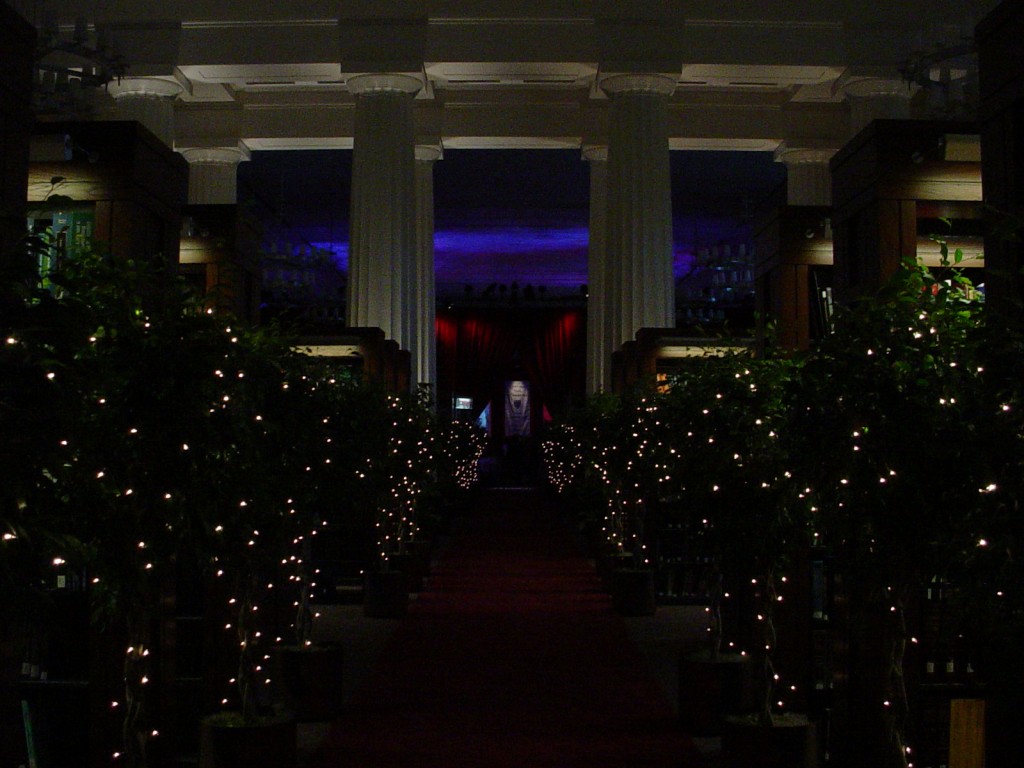Crossing the very fine – though deeply nuanced – line that lies between the Minefield of Unexplored Assumption and the Poppyfield of Preconception (that’s an oblique, metaphorical “Wizard of Oz” reference that I just made up…) is where one often encounters what is, essentially, the product of those pesky Assumptions that call for exploration throughout the process of creative development and production.
Preconception springs eternal; from the mounting of a production in a venue, theatre or location with which an audience is already familiar to telling a story the audience is inclined to think they already know…people think they know all the stories and how each is told.
Let ‘em think that…until they are in your control, under your influence; then, turn the proverbial tables. Sometimes this can be as simple as turning a room around and entering through an unforeseen doorway, entering a theatre through the stage door and across the stage, even seating on the stage with the performance coming from various parts of the auditorium. You’ve probably done this sort of thing in your work, installations, productions…
The thing about Preconception is that it’s a Conversation, going on inside the head of an audience member, reassuring that s/he is, indeed, on top of this thing. S/he knows what’s going to happen and what’s next and then what’s next and within seconds of an experience launching, each member of the audience can be rapt in their own, individual reveries and not even paying attention to what you have produced.
On the one hand, this is great; the audience is happy, as they are getting what they expected … they expected to like it and they do. Nice. Nice emotions come to the fore, nice memories come off the virtual shelf. The experience is Nice. I think, though, that we can often go far deeper into the store of cherished experience on which to call when striving to evoke than is most commonly executed.
Example: In creating the opening film for a national tour of campaign experience for Stanford University Alumni, I strove to create something that would re-ignite the wonder and excitement of discovering that campus for the first time. Up to then, pretty much every media piece for the university traditionally opened with a shot of the iconic, main entrance to the campus; Palm Drive, the Oval, the Arches, the Quad, Memorial Church, the foothills in the background or some combination of these. The same tradition was reflected in most major print pieces of the institution.
My theory is that, when presented with such a regular and familiar (though beautiful) litany of imagery, the minds and imaginations of the audience are immediately stimulated to call up the easiest memories; games of frisbee on the oval lawn, who they played with, what a great time were the University Years…within seconds, they’ve left the experience, the narrative that may be unfolding before them and are off on their own, familiar path of reverie. Again, Nice; though perhaps not as deeply moving and compelling as it might be.
So, what we designed was a short, wordless film with a lush, evocative score that began with a solo cyclist in the foothills behind campus. These foothills are protected land, and any experience an alum would have of these would be an intimate one; a lone, exploratory walk, a small, practical seminar, time with a loved one, even a proposal of marriage…no large groups or big experiences. This set the stage, from the outset, for circumventing, for liberating, preconception.
The journey of three minutes took our cyclist out of the foothills and onto campus from behind, taking a bit of a circuitous route past some familiar architecture and landmarks, along the lake, past the stables, down fraternity row, through this plaza and that archway with familiar campus activities taking place as he passed by… The net effect was a tour of campus with quick glimpses of the new, adjacent to the familiar.
Suddenly the clock began to strike and the cyclist realized he was going to be late for class; speeding up as he flew past students and classrooms, arriving at his destination at the final second, just as his (familiar to generations of alumni) professor entered and the seminar began.
As he breathed a sigh of relief, the camera left him and, as the music built, a rapid montage of photos from eleven decades of university history flew past to reveal a panoramic flyover shot of what the audience had expected to see at the beginning of the film; the oval, the church, the quad, the arches… No one was disappointed; and most all were able to see these icons in a different light than had they been presented as matter-of-fact at the beginning.
In the first 30 seconds of the film, the audience went completely quiet, save the occasional gasp of recognition of a building or pathway. At the end of the three minutes, however, the audience erupted into spontaneous applause and cheering to match that of the film’s soundtrack. Their heads and hearts were indisputably back “on campus,” and they were freshly aware of an excitement rarely felt since adolescence. They also knew that they didn’t know what was coming next, and anticipation was heightened in the room.
It worked. (…this film can be viewed, here: Stanford “Think Again” films #1: Back to the Farm – YouTube )
The same theory worked in a far different way when launching a campaign at Harvard Law. Rather than bringing the audience into the Law Library for the Main Event the way they’d always entered this space…this space they had come to Harvard and discovered in awe, then learned to hate by the time of departure…we brought them up the emergency stairs and into darkened, architecturally-lit stacks from a position seldom experienced. One in which they entered and saw the beauty of the unobstructed rows of columns bisecting the room and the stacks from end-to-end, the long way.
Suddenly, these jaded lawyers were immersed in the beauty of the space and reminded of the reverence with which they had once held these thousands of tomes.
So, after and along with “what are they assuming,” comes “what are they expecting?” And, how might we work with that and Liberate said Preconception…?
Ain’t nothing wrong with a little slyness in the name of Compelling Experience…
Again, thanks for reading.
“Ah, but a man’s reach should exceed his grasp, or what’s a heaven for?”
-Robert Browning
Next week: Comfortable Disorientation

